Aortic intramural hematoma
Editor-In-Chief: C. Michael Gibson, M.S., M.D. [1]
Associate Editor-In-Chief: Cafer Zorkun, M.D., Ph.D. [2]
Overview
- Aortic intramural hematoma is classically abbreviated as IMH.
- It may occur as a primary event in hypertensive patients in whom there is spontaneous bleeding from vasa vasorum into the media or may be caused by a penetrating atherosclerotic ulcer.
- Intramural hematoma may also develop as a result of blunt chest trauma with aortic wall injury.
- Thought to begin with the rupture of the vasa vasorum, the blood vessels that penetrate the outer half of the aortic media from the adventitia and arborize within the media to supply the aortic wall.
- The hematoma propagates along the media layer of the aorta.
- Consequently, intramural hematoma weakens the aorta and may progress either to outward rupture of the aortic wall or to inward disruption of the intima, the latter leading to communicating aortic dissection.
- Unlike aortic dissection, no intimal flap is present.
- If it involves the ascending aorta, treatment is surgical to prevent rupture or progression to a classic aortic dissection.
- Conservative management is indicated for aortic intramural hematomas of the descending aorta.
Historical Perspective
- The diagnosis of aortic intramural hematoma dates back to early 1980s when the choice of diagnosis was Trans-esophageal echocardiography.[1]
Classification
- IMH is classified into two types on the basis of Standford classification.[2]
- Type A IMH: involves the ascending aorta, and may or may not involve descending aorta
- Type B IMH: involves the descending aorta only distal to left subclavian artery
Pathophysiology
- The pathogenesis of IMH is characterized by either rupture of vasa vasorum or tea in the intimal layer.
- Rupture of vasa vasorum is seen in the majority of cases, which separates medial wall of the aorta leading to a tear but there is no continuous flow. The hematoma is contained within the wall.[3]
- Small microscopic tear in the penetrating aortic ulcer is another mechanism leading to formation of IMH. These ulcers are mostly associated with atherosclerotic changes of the aortic wall as well.[3]
- On microscopic histopathological analysis, hematoma is seen in the media layer of the aorta.
Clinical Features
Pain is the most common presentation of patients with IMH. The location of pain depends on the location of IMH.
Chest pain is the most common presenting symptoms in 82.5 % of the patients, followed by back pain (41%), abdominal pain (13.1%).[3]
Pain is reportedly severe on onset in almost all the cases, abrupt in onset. Radiation of pain is seen 45.9% of patients.
Upto 32% of these patients can present with hypertension, whereas a minority(11.9%) present with hypotension.
Patient with Type A IMH can present with murmur of aortic regurgitation (35.2%) and pulse deficit is seen in a minority(15.1%) of the patients.
Differentiating Aortic Intramural Hematoma from other Diseases
- IMH must be differentiated from other diseases that cause sudden onset chest pain, back pain, abdomen pain with or without radiation such as:
- Aortic Dissection
- Acute Coronary Syndrome
- Pulmonary Embolism
- Renal Infarct
- Mesenetric ischemia
- Trauma to the back
Epidemiology and Demographics
- The prevalence of IMH is approximately 2 to 4 cases per 100,000 individuals worldwide.
- In [year], the incidence of [disease name] was estimated to be [number or range] cases per 100,000 individuals in [location].
Age
- Patients of all age groups may develop [disease name].
- [Disease name] is more commonly observed among patients aged [age range] years old.
- [Disease name] is more commonly observed among [elderly patients/young patients/children].
Gender
- [Disease name] affects men and women equally.
- [Gender 1] are more commonly affected with [disease name] than [gender 2].
- The [gender 1] to [Gender 2] ratio is approximately [number > 1] to 1.
Race
- There is no racial predilection for [disease name].
- [Disease name] usually affects individuals of the [race 1] race.
- [Race 2] individuals are less likely to develop [disease name].
Risk Factors
- Common risk factors in the development of [disease name] are [risk factor 1], [risk factor 2], [risk factor 3], and [risk factor 4].
Natural History, Complications and Prognosis
- The majority of patients with [disease name] remain asymptomatic for [duration/years].
- Early clinical features include [manifestation 1], [manifestation 2], and [manifestation 3].
- If left untreated, [#%] of patients with [disease name] may progress to develop [manifestation 1], [manifestation 2], and [manifestation 3].
- Common complications of [disease name] include [complication 1], [complication 2], and [complication 3].
- Prognosis is generally [excellent/good/poor], and the [1/5/10year mortality/survival rate] of patients with [disease name] is approximately [#%].
Diagnosis
Diagnostic Criteria
- The diagnosis of [disease name] is made when at least [number] of the following [number] diagnostic criteria are met:
- [criterion 1]
- [criterion 2]
- [criterion 3]
- [criterion 4]
Symptoms
- [Disease name] is usually asymptomatic.
- Symptoms of [disease name] may include the following:
- [symptom 1]
- [symptom 2]
- [symptom 3]
- [symptom 4]
- [symptom 5]
- [symptom 6]
Physical Examination
- Patients with [disease name] usually appear [general appearance].
- Physical examination may be remarkable for:
- [finding 1]
- [finding 2]
- [finding 3]
- [finding 4]
- [finding 5]
- [finding 6]
Laboratory Findings
- There are no specific laboratory findings associated with [disease name].
- A [positive/negative] [test name] is diagnostic of [disease name].
- An [elevated/reduced] concentration of [serum/blood/urinary/CSF/other] [lab test] is diagnostic of [disease name].
- Other laboratory findings consistent with the diagnosis of [disease name] include [abnormal test 1], [abnormal test 2], and [abnormal test 3].
Imaging Findings
- There are no [imaging study] findings associated with [disease name].
- [Imaging study 1] is the imaging modality of choice for [disease name].
- On [imaging study 1], [disease name] is characterized by [finding 1], [finding 2], and [finding 3].
- [Imaging study 2] may demonstrate [finding 1], [finding 2], and [finding 3].
Other Diagnostic Studies
- [Disease name] may also be diagnosed using [diagnostic study name].
- Findings on [diagnostic study name] include [finding 1], [finding 2], and [finding 3].
Treatment
Medical Therapy
- There is no treatment for [disease name]; the mainstay of therapy is supportive care.
- The mainstay of therapy for [disease name] is [medical therapy 1] and [medical therapy 2].
- [Medical therapy 1] acts by [mechanism of action 1].
- Response to [medical therapy 1] can be monitored with [test/physical finding/imaging] every [frequency/duration].
Surgery
- Surgery is the mainstay of therapy for [disease name].
- [Surgical procedure] in conjunction with [chemotherapy/radiation] is the most common approach to the treatment of [disease name].
- [Surgical procedure] can only be performed for patients with [disease stage] [disease name].
Prevention
- There are no primary preventive measures available for [disease name].
- Effective measures for the primary prevention of [disease name] include [measure1], [measure2], and [measure3].
- Once diagnosed and successfully treated, patients with [disease name] are followed-up every [duration]. Follow-up testing includes [test 1], [test 2], and [test 3].
Examples

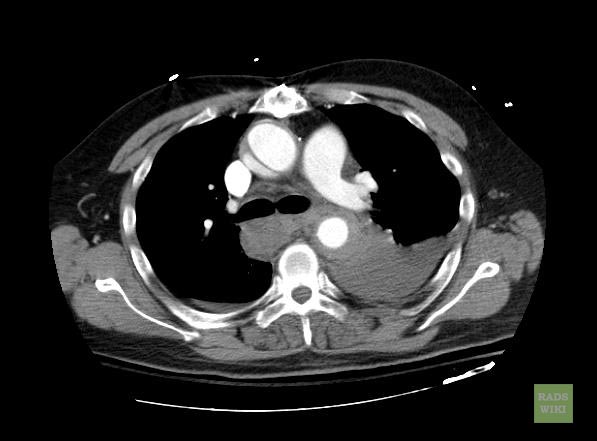
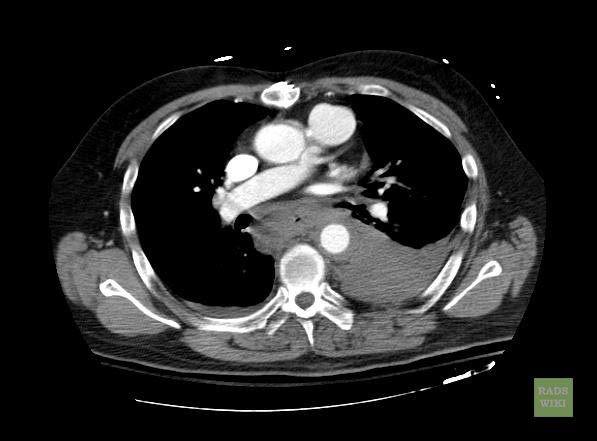
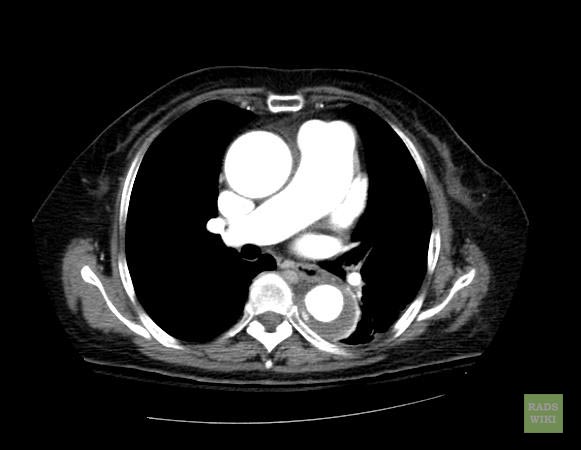
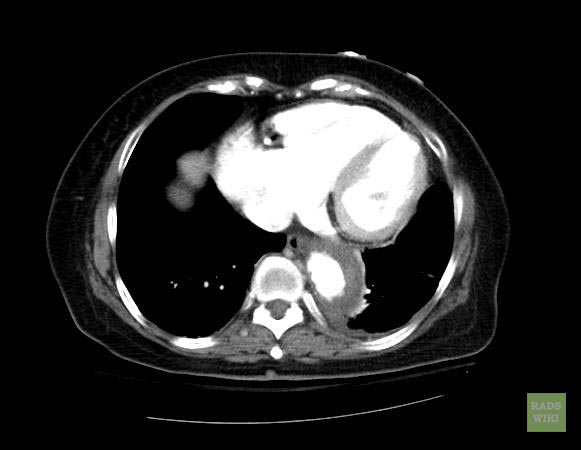
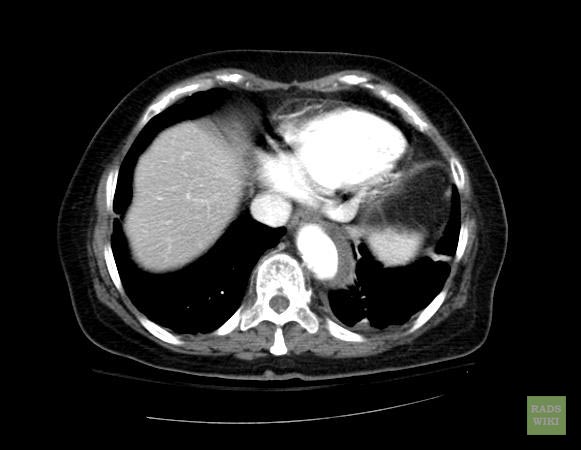
- Macura, Katarzyna J., Corl, Frank M., Fishman, Elliot K., Bluemke, David A. Pathogenesis in Acute Aortic Syndromes: Aortic Dissection, Intramural Hematoma, and Penetrating Atherosclerotic Aortic Ulcer. Am. J. Roentgenol. 2003 181: 309-316.
- Gomez-Jorge, Jackeline. E-medicine rads article
See also
External Links
References
- ↑ Vilacosta I, San Román JA, Ferreirós J, Aragoncillo P, Méndez R, Castillo JA; et al. (1997). "Natural history and serial morphology of aortic intramural hematoma: a novel variant of aortic dissection". Am Heart J. 134 (3): 495–507. PMID 9327708.
- ↑ Lempel JK, Frazier AA, Jeudy J, Kligerman SJ, Schultz R, Ninalowo HA; et al. (2014). "Aortic arch dissection: a controversy of classification". Radiology. 271 (3): 848–55. doi:10.1148/radiol.14131457. PMID 24617732.
- ↑ 3.0 3.1 3.2 Alomari IB, Hamirani YS, Madera G, Tabe C, Akhtar N, Raizada V (2014). "Aortic intramural hematoma and its complications". Circulation. 129 (6): 711–6. doi:10.1161/CIRCULATIONAHA.113.001809. PMID 24515957.